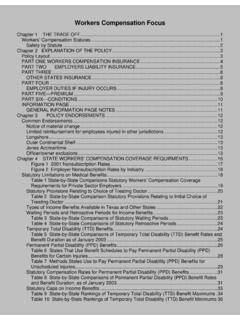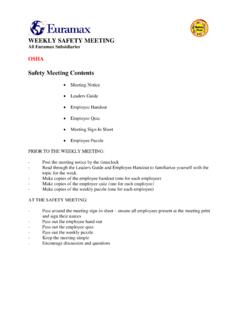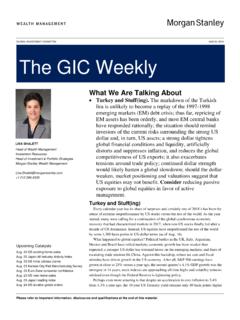Transcription of Special Focus: Measuring Leisure in OECD Countries
1 ISBN 978-92-64-04938-3 Society at a Glance 2009 OECD Social Indicators OECD 200919 Chapter 2 Special focus : Measuring Leisurein OECD Countries2. Special focus : Measuring Leisure IN OECD COUNTRIESSOCIETY AT A GLANCE 2009: OECD SOCIAL INDICATORS ISBN 978-92-64-04938-3 OECD 200920 The amount and quality of Leisure time is important for people s well-being for the directsatisfaction it brings. Additionally, Leisure , taken in certain ways, is important for physicaland mental health. Leisure also contributes to the well-being of people other than theperson directly enjoying Leisure . When a person engages in Leisure , the benefits gained areshared with others in a multitude of ways, including improvements in personalrelationships, family functioning, and in terms of creation of social capital networks (atleast from some types of shared Leisure ).
2 Leisure time patterns across the OECD thereforewarrant investigation as an important part of social exactly then is Leisure ? Leisure may be defined in terms of time, activities, orstates of mind. In terms of time, Leisure can be seen as time spent free of obligation andnecessity. For example, the quantity of Leisure has been defined as all activities that wecannot pay somebody else to do for us and we do not really have to do at all if we do notwish to (Burda et al., 2006, p. 1). Despite its advantages, this definition does notspecifically mention the types of activities that can qualify as Leisure . Nor does it describethe extent to which a person is free from obligation. Alternatively, Leisure can be definedas specific activities conventionally thought of as leisurely . A more thorough definitionmay be based on what the majority of people would list as Leisure activities, such astelevision watching, participating in sports or exercise, reading, seeing movies, and so , Leisure can be defined as a state of mind, meaning engaging in enjoyable orpleasurable activities.
3 The actual measures of Leisure used here draw on all chapter first provides a short literature review of the economic determinants ofleisure time. It then examines Leisure across the OECD as the residual time not spent inpaid work. This residual approach to the data is not ideal, in particular because it doesnot allow cross-country or inter-temporal variations in amounts of unpaid workundertaken. However, the residual approach does allow considerations of Leisure for thelargest possible cross-section/time series of Countries across the OECD. A furthercontextualisation of Leisure time is then undertaken, considering a very broad-brushallocation of time over the adult life cycle. This contextualisation is done for an averageOECD country in terms of years before compulsory education, years of schooling, yearsbefore labour market entry, years not in paid work, years in work, and years in retirementfor males and the smaller subset of 18 OECD Countries for which comparable data could beobtained, time-use studies are used to more accurately explore Leisure during a typical dayand across time (the annex to this chapter provides some comparative details of the18 time-use surveys used).
4 These time-use surveys precisely measure the time devoted toboth market and non-market activities by recording data on people s time allocation whenin or away from their jobs. Respondents descriptions of activities are coded into sets ofgeneral categories such as time spent in work , time spent doing household chores , or time spent in Leisure activities . While methodologies and approaches vary to a certain2. Special focus : Measuring Leisure IN OECD COUNTRIESSOCIETY AT A GLANCE 2009: OECD SOCIAL INDICATORS ISBN 978-92-64-04938-3 OECD 200921degree, all the time-use surveys used in this chapter define the Leisure category as thesum of non-compulsory activities such as hobbies, watching television or listening to theradio, socialising with friends and family, attending cultural events, hosting events, andpractising a sporting activity.
5 All the surveys aim to closely measure what people actuallydo with their time, not what they recollect having done with it long after the events. Onceadjusted, this data makes it possible to compare cross-national Leisure levels and employing time-use data, the second part of this chapter focuses on patterns of leisuredistribution by categories of both gender and This part of the chapter also detailsthe types of Leisure activities people engage in and the satisfaction they derivefrom accomplishing them. Finally some consideration is made of the relationshipsbetween Leisure and other measures of well-being, and Leisure and policy choices aboutpaid economic theory of Leisure timeSince Veblen s Theory of the Leisure Class at the end of the 19th century, economists andother social scientists have taken a great deal of interest in Leisure .
6 Most work on laboursupply in the neoclassical tradition focuses theoretical and empirical attention on thelabour/ Leisure choice. However, this approach traditionally ignores other uses of time. Iteffectively examines the margin between paid work and all other uses of time in aggregate( residual time ), which of course include Leisure time as a sub-set, in terms of theconstrained optimisation techniques of neoclassical economics (see Caussa, 2008 forrecent OECD work in this vein).The canonical modern treatment of time-use, explicitly addressing Leisure in a moresophisticated fashion, can be attributed to Gronau (1976). Drawing on the earlier work ofMincer, Gronau argues for a need to distinguish between unpaid work (home production)and Leisure . He suggests that the justification for focusing only the paid work/residualtime choice, a focus with which he disagrees, is based on an assumed stability of theallocation of residual time between competing uses (such as home production, Leisure ,and sleep) in response to economic changes.
7 Gronau develops a formal model with athree-fold distinction between Leisure , home production, and paid work. His model isbased on the assumption that marketed goods obtained from paid work and homeproduced goods are perfect substitutes. An increase in market wages reduces homeproduction. The wage impact on both Leisure and market work is indeterminate. Anincome rise increases Leisure , reduces paid work, and leaves home productionunchanged. Empirical work by Bloch and Gronau using United States and Israeli datasuggests that Leisure amongst couples is positively related to the husband s wage income,negatively related to the wife s wage income, and positively related to non-wage addition, higher numbers of children, and especially pre-school children, reduceleisure time (Gronau, 1976, Table 1).
8 Other extensions of labour supply models to incorporate home production includeChiappori (1997) and Apps and Rees (1996, 1997, and2002). In addition to market work,home production, and Leisure time, Gronau s model has also been extended to cover work-related travel time by Solberg and Wong (1992). Their empirical results do not concur withtheir model predictions, and the authors suggest that this is mainly due to the violation oftheir assumption (shared with Gronau) of perfect substitutability between market workand home Special focus : Measuring Leisure IN OECD COUNTRIESSOCIETY AT A GLANCE 2009: OECD SOCIAL INDICATORS ISBN 978-92-64-04938-3 OECD 200922 None of the models presented above include sleep in their consideration of Leisure . AsBiddle and Hamermesh (1990) point out, many labour supply models assume a fixedamount of time is allocated between paid work and waking Leisure .
9 By implication, sleep isa fixed biological constant, yet theory and evidence do not support this. Biddle andHamermesh theoretically and empirically show that sleep time, as with other forms oftime usage, responds to marginal economic incentives. If this is the case, some sleep alsobecomes a Leisure -like activity. As such, several very recent time-use studies havecategorised all sleep as Leisure (see Aguiar and Hurst, 2007; Engler and Staubli, 2008).Trends in residual of paid work timeThe analysis commences by considering maximum Leisure time as simply the amountof time that is not spent in paid work. While some immediate limitations of this approachare obvious it fails to consider unpaid work for example, as well as time spentcommuting its advantage is that data on hours worked are available on a comparablebasis for a large number of OECD Countries for long time periods.
10 Good comparisons bothacross Countries and across time are possible. From this initial definition of Leisure as theresidual time-not-worked it is possible to progressively build a more solid conceptualapproach which in turn allows a study of Leisure levels and trends which is, however, lessbroad in terms of OECD country is possible to estimate total annual hours of paid work for full-time equivalentworkers across a large number of OECD Countries and thus calculate the associated residual(see Table ). Of course, an evident limitation of this approach is that it says nothing aboutleisure, even as a residual value, for large and varying parts of the population of each countrythat are not actually in employment. There are numerous features of interest in Table there are considerable differences in annual hours of work of all the employed acrossthe Countries .

















